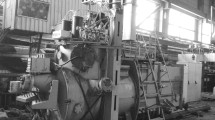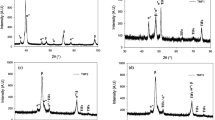Abstract
Blended elemental powder metallurgy using titanium hydride and Al–Fe–Cr master alloy powders was employed to produce a new Ti–1.5Al–1Fe–7.2Cr (wt.%) transition α + β/β metastable-type alloy. A simple process involving blending, cold pressing, and sintering resulted in a material with a residual porosity of not higher than 3.9–5%, a uniform and relatively fine-grained microstructure (average β-grain size of less than 100 μm), and acceptable mechanical properties. The influence of subsequent annealing and hot pressing on the microstructure evolution and porosity reduction was investigated. The results indicated that optimized regimes of hot deformation and heat treatment produced a structural state with a good combination of strength (UTS = 970 MPa) and ductility (El = 14.7%, RA = 35%).











Similar content being viewed by others
References
U. Zwikker, Titan und Titanlegierungen (Springer, Berlin, 1974)
G. Lutjering, J.C. Williams, Titanium (Springer, Berlin, 2003), p. 289
E.V. Collings, The Physical Metallurgy of Titanium Alloys (American Society for Metals, Materials Park, 1984), p. 261
D. Eylon, Beta-titanium alloys—an overview, in 3rd Japan International SAMPE Symposium. Tokyo, pp. 1588–1595 (1993)
M. Ikeda, S. Komatsu, K. Inoue, H. Shiota, T. Imose, Microstructure and tensile properties of Ti–Fe–Cr alloys. Mater. Sci. Technol. 16, 605–608 (2000)
M. Ikeda, S. Komatsu, M. Ueda et al., Influence of aluminum addition on tensile properties and aging behavior of Ti–Fe–Cr–Al alloys, in Proceeding of the Fourth Pacific Rim International Conference on Advanced Materials and Processing (PRICM4), ed. by S. Hanada, Z. Zhong, S. W. Nam, R.N. Wright. Sendai: Japan Institute of Metals, pp. 213–216, 2001
O.M. Ivasishin, P.E. Markovsky, Enhancing the mechanical properties of titanium alloys with rapid heat treatment. JOM 7, 48–52 (1996)
P.E. Markovsky, High-strength states in titanium alloys subjected to intensive heat impact. Metallofiz. I noveishie tekhnologii 31(4), 511–535 (2009)
O.M. Ivasishin, D.G. Savvakin, The impact of diffusion on synthesis of high-strength titanium alloys from elemental powder blends. Key Eng. Mater. 436, 113–121 (2010)
O.M. Ivasishin, D.G. Savvakin, M.M. Gumenyak, A.B. Bondarchuk, Role of surface contamination in titanium PM. Key Eng. Mater. 520, 121–132 (2012)
Y.C. Huang, S. Suzuki, H. Kaneko, T. Sato, Continuous cooling—transformation of β-phase in binary titanium alloys, in The Science, Technology and Application of Titanium (Oxford, Pergamon Press, 1966), pp. 695–698
F. Duwez, The effect of the rate of cooling on the α → β transformation in Ti and Ti–Mo alloys. Trans. AIME 191, 765–771 (1951)
V.N. Gridnev, O.M. Ivasishin, P.E. Markovsky, Influence of heating rate on the temperature of the (α+β)→β transformation of titanium alloys, Met. Sci. Heat Treat. 27, 43–48 (1985)
F. Elstner, C. Gautier, O. Piot, G. Contoux, F. Cosset, F. Nardou, J. Machet, Comparative study of the stress in chromium films deposited by vacuum arc evaporation, vacuum evaporation, and DC magnetron sputtering. Phys. Status Solidi 154(2), 669–679 (1996)
O.M. Ivasishin, P.E. Markovsky, YuV Matviychuk, S.L. Semiatin, Precipitation and recrystallization behavior of beta titanium alloys during continuous heat treatment. Metall. Mater. Trans. A 34, 147–158 (2003)
O.M. Ivasishin, P.E. Markovsky, S.L. Semiatin, C.H. Ward, Aging response of coarse- and fine-grained beta-titanium alloys. Mater. Sci. Eng. 405(1–2), 296–305 (2005)
O.P. Karasevska, O.M. Ivasishin, S.L. Semiatin, YuV Matviychuk, Deformation behavior of beta-titanium alloys. Mater. Sci. Eng. A 354, 121–132 (2003)
E.V. Pereloma, Private communication, University of Wollongong
Author information
Authors and Affiliations
Corresponding author
Rights and permissions
About this article
Cite this article
Markovsky, P.E., Ikeda, M., Savvakin, D.G. et al. Microstructure and Properties of New Ti–Al–Fe–Cr Transition Class Alloy Produced by Blended Elemental Powder Metallurgy Using TiH2 and Master Alloy. Metallogr. Microstruct. Anal. 7, 184–193 (2018). https://doi.org/10.1007/s13632-018-0427-4
Received:
Revised:
Accepted:
Published:
Issue Date:
DOI: https://doi.org/10.1007/s13632-018-0427-4




